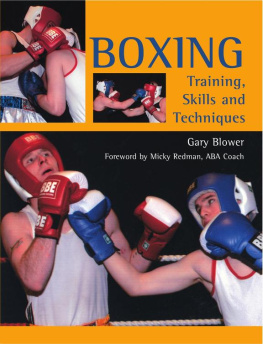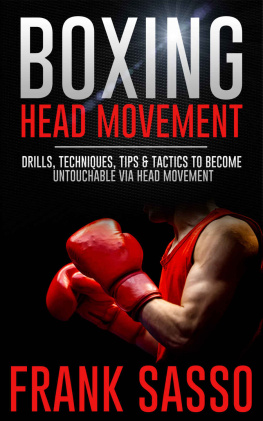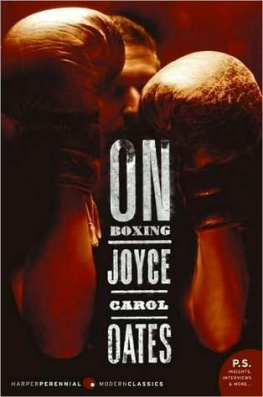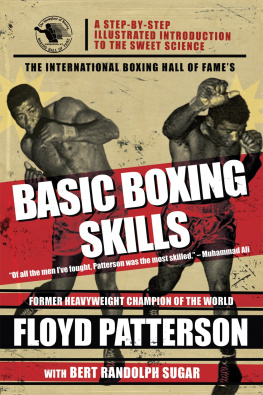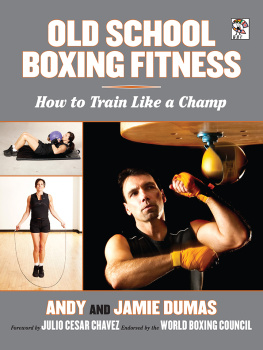Leeanne Reindl - Boxing - From Chump to Champ: A Step - by - Step guide to Boxing
Here you can read online Leeanne Reindl - Boxing - From Chump to Champ: A Step - by - Step guide to Boxing full text of the book (entire story) in english for free. Download pdf and epub, get meaning, cover and reviews about this ebook. year: 2020, genre: Children. Description of the work, (preface) as well as reviews are available. Best literature library LitArk.com created for fans of good reading and offers a wide selection of genres:
Romance novel
Science fiction
Adventure
Detective
Science
History
Home and family
Prose
Art
Politics
Computer
Non-fiction
Religion
Business
Children
Humor
Choose a favorite category and find really read worthwhile books. Enjoy immersion in the world of imagination, feel the emotions of the characters or learn something new for yourself, make an fascinating discovery.

- Book:Boxing - From Chump to Champ: A Step - by - Step guide to Boxing
- Author:
- Genre:
- Year:2020
- Rating:4 / 5
- Favourites:Add to favourites
- Your mark:
- 80
- 1
- 2
- 3
- 4
- 5
Boxing - From Chump to Champ: A Step - by - Step guide to Boxing: summary, description and annotation
We offer to read an annotation, description, summary or preface (depends on what the author of the book "Boxing - From Chump to Champ: A Step - by - Step guide to Boxing" wrote himself). If you haven't found the necessary information about the book — write in the comments, we will try to find it.
Leeanne Reindl: author's other books
Who wrote Boxing - From Chump to Champ: A Step - by - Step guide to Boxing? Find out the surname, the name of the author of the book and a list of all author's works by series.
Boxing - From Chump to Champ: A Step - by - Step guide to Boxing — read online for free the complete book (whole text) full work
Below is the text of the book, divided by pages. System saving the place of the last page read, allows you to conveniently read the book "Boxing - From Chump to Champ: A Step - by - Step guide to Boxing" online for free, without having to search again every time where you left off. Put a bookmark, and you can go to the page where you finished reading at any time.
Font size:
Interval:
Bookmark:
Copyright 2020
All rights reserved.
DEDICATION
The author and publisher have provided this e-book to you for your personal use only. You may not make this e-book publicly available in any way. Copyright infringement is against the law. If you believe the copy of this e-book you are reading infringes on the author's copyright, please notify the publisher at: https://us.macmillan.com/piracy
Contents

Boxing or pugilism is a combat sport, which fights only with the hands in gloves, and has several rules and regulations so that the sport is not so violent or barbaric.
Boxing originated in England, between the eighteenth and nineteenth centuries, which was fought with bare hands, making it a very brutal and violent sport.
Years later this sport started to be regulated, especially in 1867 with the formulation of the Queensberry Rules.
Boxing has always been an Olympic sport, not being present only at the 1912 Olympic Games in Stockholm, since at that time sport was banned in the country.
Over the years many boxing variations have emerged, the most famous of which are Thai Muay Thai and French Savate, who are already using their legs.
The boxing ring is square and should have on the side between 4,9 and 7 meters. It has four elastic strings, with a diameter between 3 and 5 centimeters, and they must be hung on the posts at 41, 71, 102 and 132 inches from the ground of the ring.
The posts should be coated with a smooth surface, so the boxers do not get hurt when they hit one of them.

The rules of Olympic Boxing have some differences from Professional Boxing, which this uses the rules of Amateur Boxing.
Some of the differences are that those of Olympic Boxing have to wear a head protector while in the professional it is prohibited to wear. In amateur boxing, it also only goes up to the four rounds as the professional goes to the 12 rounds.
The way to win is also different, counting the points differently.
The goal of boxing is to hit the most direct hits on the opponent, and in the end the judges make a vote between them until reaching a verdict on which of the athletes made more points with the blows.
There are other ways to win, and they are:
Have an opponent fall 2 to 3 times on the canvas in the same round (the number depends on the competition);
Knock out, when the opponent lands on the ground or rests on the ropes, and the referee counts up to 10 and the athlete can not stand up at that time;
The referee may also score a technical knockout. This happens when one of the boxers is taking with many consecutive blows and the referee considers that he is not able to receive them;
Lastly, one of the assistants can throw the towel to the floor, meaning that they are giving up the fight;

The number of people involved in combat other than the boxers is still high, and each has its function: Lets see what they are and what they do.
Referee
The referee is responsible for complying with the rules of the boxers, being within the ring to control the behavior of the athletes and intervening when the situation demands it;
Judges
In a combat 3 judges are present, who have like responsibility to count the blows of each boxer and thus decide who gains the combat, if there is no knockout;
Doctor
A physician should always be present to assess the condition of the boxers during combat, ascertaining whether he is able to continue the fight;
Timekeeper
This is responsible for the time of the round and touches the gong, which is used to mark the end of each round;
Technical director
The Technical Director is responsible for judges decisions, reviewing them and announcing the result. He is also responsible for other decisions in combat;
Locutor
He is responsible for making the announcements of the results of the fights, presentation of the fighters, authorities, referee, judges, etc.
Assistants
Each boxer is entitled to have four assistants, who are behind the fighters post (red corner or blue corner) and have the responsibility to advise the boxer, deal with him and throw in the towel when he thinks he is no longer able to continue fight;
Sparing
Sparing is the name given to the fighters who are responsible for training with other boxers. They are usually amateur or early-career fighters and often even become great boxers and champions, including Larry Holmes, sparing Muhammad Ali.
For fights to be as fair as possible, boxers are divided into weight categories. Thus each boxer only fights with another boxer of similar weight to his, making the fighting much more fair and balanced.
The male weight categories are as follows:
Light Fly 48 pounds
Fly 51 pounds
Rooster 54 pounds
Worth 57 pounds
Lightweight 60 pounds
Light Middle Medium 64 pounds
Average middle -69 pounds
Medium 75 pounds
Medium-heavy 81 pounds
Heavy 91 pounds
Super heavy + 91 pounds
Some of the rules of the Professional Boxing fights are:
Strokes are only considered scoring if they are hit from the front or the side of the head or the abdomen of the opponent. Scores on the arms are not scored.
Punching the back of the head, grabbing or striking below the waist are infractions. When done, the referee gives a warning to the boxer. If this is repeated again, the boxer may be disqualified.
The boxer can not strike his opponent while he is on the ground;
Bites are also cause for warning and potential disqualification; 
- Direct: Fast and strong blow that hits the front of the opponent with the fist that was behind the guard.
- Jabe: The same as the direct, only with the other fist, which is the front in the guard.
- Crusader: As strong as the direct but hits the side of the opponents head. In this movement, the arm ends flexed, unlike the direct.
- Hook: Movement of the wrist in a curved trajectory that reaches the side of the head or the abdomen of the fighter.
- Uppercut: Blow done from the bottom up to aim at the other fighters chin.
- Jab-direct: Mixing the direct blow with the jab blow, i.e. the fighter gets punching the opponent with both hands at the same time.
"It's hard to be humble, when you're as great as I am." Muhammad Ali (1942-2016).
Several time world champion boxer in the heavyweight category, Muhammad Ali arouses adoration raised to the rank of adulation, as much as he incites criticism.
Even today, the late world champion of boxing ranks at the top as the greatest legend of the sport.
In addition to being undefeated in the boxing ring during his glory days, he embodies a humanitarian model to follow, an intelligence at the service of progress and human rights.
Font size:
Interval:
Bookmark:
Similar books «Boxing - From Chump to Champ: A Step - by - Step guide to Boxing»
Look at similar books to Boxing - From Chump to Champ: A Step - by - Step guide to Boxing. We have selected literature similar in name and meaning in the hope of providing readers with more options to find new, interesting, not yet read works.
Discussion, reviews of the book Boxing - From Chump to Champ: A Step - by - Step guide to Boxing and just readers' own opinions. Leave your comments, write what you think about the work, its meaning or the main characters. Specify what exactly you liked and what you didn't like, and why you think so.

